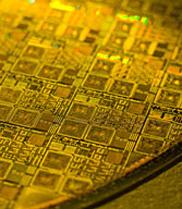CSIRO chip a boon for mobile industry

CSIRO and Australian technology company Sapphicon announced yesterday that they were jointly developing a complete radio receiver on a chip measuring 5x5mm that could have a range of potential applications for the telecommunications industry.

Silicon-on-Sapphire wafer (Credit: CSIRO)
The chip would replace traditional receivers used in radio astronomy applications that are the size of fridges, according to the CSIRO. It could also reduce manufacturing costs up to 10 to 100 times.
The chip receiver is part of a larger $100 million project announced in 2008 to build a network of radio telescopes known as the Australian Square Kilometre Array Pathfinder (ASKAP).
The chip enables fast and broad spectrum analysis, which makes it of particular interest to the mobile telecommunications industry.
"The frequency bands in which the radio telescope operates basically covers the mobile phone bands. That's what makes it potentially applicable to mobile phone applications, we anticipate that it could be used in things like mobile phone base stations," said Sapphicon's vice president Andrew Greatbach.
"If you're designing a mobile phone tower or something for example, one of the tests they'll do is analyse the spectrum that their antennas are putting out to make sure that they're only radiating in the band that they're supposed to be radiating in," CSIRO engineer Suzy Jackson said, adding that it would also be applicable for TV signal transmitters and areas with radio transmitters.
However, the primary driver of the technology is the way it could revolutionise radio astronomy, according to the CSIRO's ASKAP project director Dr David DeBoer. The key advantage is that it integrates a plethora of circuitry into the same chip.
"RF, logic, mixed-signal and passives — can be incorporated into the same chip. This is real miniaturisation and could open up whole new product markets," DeBoer said in a statement.
"Australia is a reasonably small country and I think it's really cool that we can support this innovation. Previously I've gone overseas to get a chip made and I think it's really awesome that we can do it right here in Australia," said Jackson.